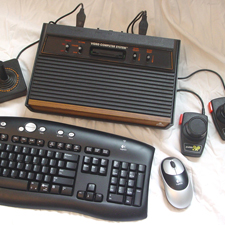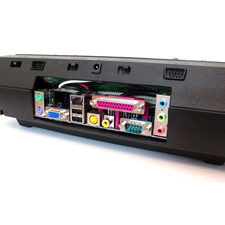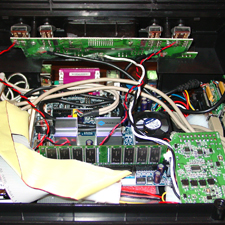Atari 2600PC



The Atari 2600PC is a fully-featured PC designed into the case of a retro Atari 2600 video game system. It serves as a DVD/CD media station and an all-purpose video game and computer emulator.
In 1977, when Atari introduced the Video Computer System (VCS)—later renamed the 2600—nobody, not even Atari, knew it would ultimately become a wild success and be the catalyst that would spawn today’s multibillion-dollar gaming industry. The aesthetics of the Atari 2600 is recognized around the world and it seemed like a natural choice for a high-tech makeover.
The step-by-step process of creating the Atari 2600PC is detailed in Chapter 2 of Game Console Hacking.
The heart of the Atari 2600PC consists of a VIA EPIA M10000 motherboard. Based around the popular Mini-ITX form factor, it measures only 17 cm by 17 cm (6.7 inches per side). The board contains a 1GHz Nehemiah C3 microprocessor (which is an Intel clone that performs comparably to a Pentium III in benchmark tests) and VIA’s CLE266 and VT8235 core-logic chip set. On-board peripherals include a six-channel AC’97 codec, accompanying an S/PDIF (Sony/Philips digital interface) audio-output option; a dual-channel FireWire transceiver; four USB 2.0 ports; 100Mb/second Ethernet interface; and an NTSC/PAL TV-out encoder. The M10000 supports two ATA133 mass storage channels and a floppy drive connection. A graphics accelerator on board the CLE266 handles 128-bit, two-dimensional and 64-bit, three-dimensional graphics acceleration and includes hardware support for various MPEG-2 decoding tasks.
Supporting hardware includes Micron DDR 512MB PC2100 DRAM (266-MHz, 184-pin), Fujitsu MHS2060AT 60GB 2.5-inch laptop hard drive, Samsung SN-324 slim CD-RW/DVD combo drive, iTuner PW-70 ATX power supply module, Logitech Cordless Access Duo Optical wireless keyboard and mouse, D-Link DWL-122 802.11b wireless USB adapter, and two Stelladaptor Atari 2600 Controller to USB Interfaces (which allow original Atari 2600 joysticks, paddles, and driving controllers to be connected directly to the PC).
In order to retain as much of the look and feel of the Atari system as possible, the original control panel (containing the cartridge slot, switches, and rear connectors) remains intact. The Power On/Off switch is used to power on the PC and the Game Reset switch is used to enable the wireless keyboard and mouse. The Left and Right Controller inputs on the rear of the Atari accept original Atari controllers and serve as Player 1 and Player 2, respectively. The power supply jack is used to provide power to the PC.
The system is running Windows XP Professional and contains emulators for the Atari 2600, Atari 5200, Atari 7800, Atari 8-bit home computer, Apple ][e, RCA Studio II, Channel F, Nintendo NES, Nintendo Virtual Boy, Sega Master System, and Sega Genesis. PowerDVD XP handles the playing of DVDs and Windows Media Player supports the playing of audio CDs.